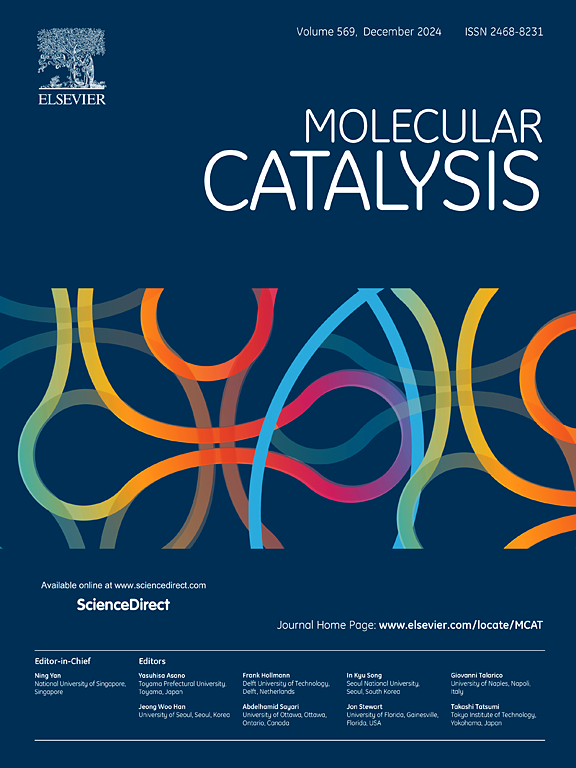A DFT study on the active surfaces of the ZnGa2O4 spinel catalyst for CO2 hydrogenation to methanol
IF 4.9
2区 化学
Q2 CHEMISTRY, PHYSICAL
引用次数: 0
Abstract
In this work, we constructed the low Miller index surfaces of (100), (001), (111), and (110) of the ZnGa2O4 spinel catalyst. Through extensive DFT calculations, we found that the oxygen vacancy (VO) formation energies on the (100) and (001) surfaces were <1.0 eV, whereas those on the (111) and (110) surfaces were >3.0 eV. We further examined the dissociation of molecular hydrogen (H2) on these surfaces, and found that H2 homolytic dissociation tended to occur on surfaces with lower VO formation energies, while H2 heterolytic dissociation were favored on those with higher VO formation energies. CO2 adsorption and activation on the different surfaces of the ZnGa2O4 spinel catalyst were investigated, and on surfaces with lower VO formation energies, CO2 adsorbs in a linear configuration (ln-CO2*), while on surfaces with higher VO formation energies, CO2 adopts in a bent adsorption geometry (bt-CO2*) and is easier to dissociate. For HCOO formation from ln-CO2* + H*, the (110) surface has the lowest energy barrier, so it is likely the most active surface for CO2 hydrogenation to methanol (CH3OH). Thus, we compared the CH3OH formation pathway on the ZnGa2O4(110) surface with the pathways for direct and indirect CO2 dissociation, and predicted it to favor CH3OH production. Our calculations reveal the active surfaces of the ZnGa2O4 spinel catalyst for CO2 hydrogenation to CH3OH, and provide insights into the experimentally observed high CH3OH selectivity, which should be important for the rational design of Zn-based spinel catalysts for this reaction.

ZnGa2O4尖晶石催化剂活性表面的DFT研究
在这项工作中,我们构建了ZnGa2O4尖晶石催化剂的(100),(001),(111)和(110)的低米勒指数表面。通过广泛的DFT计算,我们发现(100)和(001)表面的氧空位(VO)形成能为<;1.0 eV,而(111)和(110)表面的氧空位形成能为>;3.0 eV。我们进一步研究了分子氢(H2)在这些表面上的解离,发现H2均解解倾向于发生在VO形成能较低的表面上,而H2异解倾向于发生在VO形成能较高的表面上。研究了CO2在ZnGa2O4尖晶石催化剂不同表面上的吸附和活化,在VO生成能较低的表面上,CO2以线性构型(ln-CO2*)吸附,而在VO生成能较高的表面上,CO2采用弯曲吸附构型(bt-CO2*),更容易解离。对于ln-CO2* + H*生成HCOO,(110)表面具有最低的能垒,因此它可能是CO2加氢生成甲醇(CH3OH)最活跃的表面。因此,我们将ZnGa2O4(110)表面的CH3OH生成途径与直接和间接CO2解离途径进行了比较,并预测其有利于CH3OH的生成。我们的计算揭示了ZnGa2O4尖晶石催化剂的活性表面,并提供了实验观察到的高CH3OH选择性的见解,这对于合理设计用于该反应的锌基尖晶石催化剂具有重要意义。
本文章由计算机程序翻译,如有差异,请以英文原文为准。
求助全文
约1分钟内获得全文
求助全文
来源期刊

Molecular Catalysis
Chemical Engineering-Process Chemistry and Technology
CiteScore
6.90
自引率
10.90%
发文量
700
审稿时长
40 days
期刊介绍:
Molecular Catalysis publishes full papers that are original, rigorous, and scholarly contributions examining the molecular and atomic aspects of catalytic activation and reaction mechanisms. The fields covered are:
Heterogeneous catalysis including immobilized molecular catalysts
Homogeneous catalysis including organocatalysis, organometallic catalysis and biocatalysis
Photo- and electrochemistry
Theoretical aspects of catalysis analyzed by computational methods
 求助内容:
求助内容: 应助结果提醒方式:
应助结果提醒方式:


